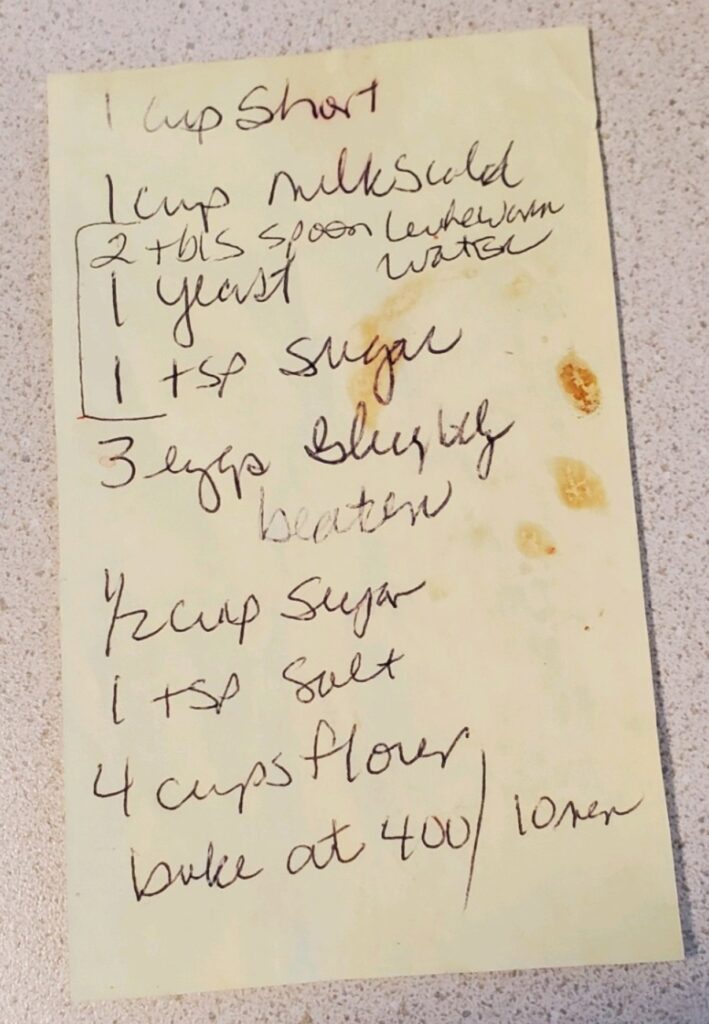By Jaclyn Johnson
Two months ago the cast of A Driftless Christmas was gathered in a virtual meeting discussing holiday traditions when crescent rolls popped into my head. Baking and cooking have always been a part of my family’s traditions around the holidays, and these rolls are my favorite part of the whole meal. Partly because they are delicious, but mostly because of the connections I feel when making them. Connection to food. Connection to my family. And connection to my ancestry.

The rolls, like so many of the ideas, memories, and imagery that came out of our creative process for A Driftless Christmas, examine one aspect of how we celebrate together, and why. As my fellow castmates shared stories about past holidays—moments of peace, moments of crisis, moments of laughter, moments of hope, moments yet to come—we emotionally came together. I hope audiences will feel that same sense of connection as they listen and that they know we miss them, and we cannot wait to share more stories with them. So here’s a bonus story about the recipe that reminds me of the unseen connections we make in life and the traditions that help us to carry them with us.
Crescent Rolls
Soft, flaky, melt-in-your-mouth Crescent Rolls.
My Grandma Helen passed away almost ten years ago but these legacies remain. The all-holiday must-haves at our house, Grandma Erstad’s Crescent Rolls. I made them with my mother, my mother made them with her mother, my grandmother made them with her mother.
A simple nine ingredient recipe I can never remember. While I can’t recite this ancestral poetry from memory, I can recall exactly how to do each step. And that’s where the real history lives, in the mixing, the resting, the rolling, the baking.
As my mother is pulling out her recipes and flipping through the pages of her books, she tells me, “I wanted to call her the other day, isn’t that odd.” It’s not odd and I can’t help but feel a bit of dread for the day when I think a similar thought. As a child I loved baking with my mom. Each holiday I held pride in the traditional foods I would prepare; the cookies, the jello salads, the pickle dish, and of course the Crescent Rolls.

So I call my mom to ask her for the crescent rolls recipe. She laughs. It was her own holiday tradition once, to call her mother and ask, yet again, for the matriarchal library to open. For the knowledge to be relayed in voice again. For grandma to file through her resources. Then finding the famous rolls recipe; pause, adjust her glasses, say “let me see now,” refocus on how to read her own writing. Being mindful of the tablespoons versus teaspoons, of the order of ingredients being added, of the wording around how to mix; to beat, to stir, to fold, or the seemingly business-orientated, to incorporate…
My mom, like me, recalls recipes by how they look. So as she is searching, I know she is looking for an index card (no lines), with her messy handwriting scrawling about ten lines of text. It’s probably tucked like a bookmark into the pages of one of her books, all of which I can picture in my mind… Her Betty Crocker cookbook with the orange cover featuring a six-piece trivial pursuit pie of 70s era show-stopping dishes on the front. The late 90s recipe-share book from her employment with Lynx, for which she typed up Grandma Belinda’s sugar cookies—which is nice because there is no second-guessing the messy writing of our ancestral hands, an apparent familial legacy which I’ve also inherited. And of course, the various index cards. Each with a different pattern of small dots of oil sucked into them, crusted egg or batter staining oblong shapes between the letters, dusty from layers of flour brushing over them throughout the years of baking.
“I used to call her every year for this recipe. Remember she used to chastise, ‘Well can ya write it down, for cryin’ out loud,’” my mom says, warmly imitating her mother’s voice.
“This was Grandma Erstad’s recipe, right?” I ask. Grandma Erstad, who was gone before I was born, is my Grandmother’s mother, in case you didn’t put that together.
“My mom read cookbooks for fun. She defined House Goddess. Think of Helen Mae believing all the tripe spewed from magazines defining her success. We were well fed with the newest recipes. But yeah, I think it was Grandma Erstad/Gravely. But I wonder because my mom mentioned a lack of white flour when she was growing up. TMI?”
“No. The best.” I tell her. Grandma Helen grew up on a farm outside of Chatfield. For some reason it feels important that I roll out her recipe this year.
The last time my mother called my grandmother for the Crescent Rolls recipe, it landed on one of those butter stained index cards. When she finds it, she offers to text it to me, but I ask her to read it. “In case I can’t read your writing,” I tease. But really, I just want to continue the tradition. I write it out as she tells me on a piece of paper. A piece of paper I only have to keep safe until the next time I call her for the recipe.
So here it is, the hundred-year-old (maybe), generation-spanning, soft, flaky, delicious, Crescent Rolls recipe:
1 cup shortening—My mother actually wrote out “short” in place of shortening. A five-letter time saver. Grandma’s version featured entire paragraphs of explanation. My mother recorded the basics of this narration, relying on the years of practice, first with her mother and then with me, around how to add what and what to do in between.
1 cup milk scalded—Her card actually looks like the word “scold,” and I laugh about this. I used to joke with her about this while we made the rolls together. I would stand at the stove top, over the small pot of milk and scold it while I watched the sides bubble up. “You’re naughty milk! Go on and get hot you bad milk, you,” I would jest. I thought I was funny. Still do, actually.
“The next three ingredients you combine together,” she notes.
2 tbls spoon lukewarm water, 1 yeast packet, 1 tsp sugar

On the card a simple bracket indicates the pairing of this scientific proof. Mom recorded no other notes around this, but it’s the standard yeast relationship. If you want those rolls to rise, do this part correctly. If you’re an expert baker you’re likely to nail this step. I myself always get anxious about this chemistry. I have no words of advice, only reassurance, they will still taste good even if they don’t rise. Unfortunately, I know that from experience.
3 eggs slightly beaten—If you were not an Udvig/Erstad/Gravely descendant I am certain you would not be able to decipher my mother’s penmanship of the word “slightly.” It looks like “brightly.” When I write the word it’s also difficult to read. I sound it out—“shishty.” Our matching archaic cursive handwriting fills me with a strange satisfaction.
½ cup sugar
1 tsp salt
4 cups flour—As a child, I enjoyed leveling the measurements. Scooping, tapping, then running a knife even across the edge of the cup. I liked the flour best of all, the effortless slide of the knife, slicing through the powder. I liked watching the edges fall away, topple and tumble in pieces which would break away to again become part of the uniform collective in the flour tin. Infinite pieces of dust that would, for a moment, cling to each other, before giving way to become part of the whole again.
Bake at 400 degrees for 10 minutes
Mom and I recounted for a bit the need to set a timer and babysit the rolls. Ten minutes go fast, and they do burn quickly. We laughed at the times we hadn’t heeded this advice. There was one notorious episode when the rolls were all so far gone an entirely new batch had to be made lest we break our teeth on blackened gluten. This is all that my mom had written down. Just the ingredients. She and I both remember the other steps because we practiced them together, year after year.
Let them rise—This is where you find out if you did the yeast step correctly. First on the counter and you can leave them overnight in the fridge. A gallon ice cream bucket is the perfect size. Cut the dough into four sections and work with one section at a time. Using your floured rolling pin, on a heavily floured surface, roll out the dough into a ¼ inch thick circle. Then you cut them, with a floured knife (you’re really gonna have to trust me on the use of flour), into 8-12 equal parts (like a pizza) and roll them into crescents. This is my favorite part. Rolling and cutting the dough and then twisting each flimsy wedge into perfect crescent shapes. Then bake them.
Mom never wasted time writing that part out. She relied on her memory to bring her to the finish line. The shared stories of burned rolls, the flat-but-tasty sad attempts, the ancestral understanding of the messy words. This familial history lives in the hands that have written the lines, the lines that spark the memories, the memories made through following these steps together. I may lose this piece of paper. But the matriarchal library is still open to me. For now, I can enjoy this comfort… For now, I can call my mom and ask her for the Crescent Rolls recipe.



